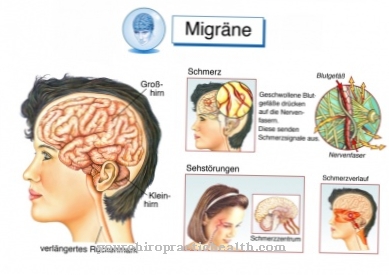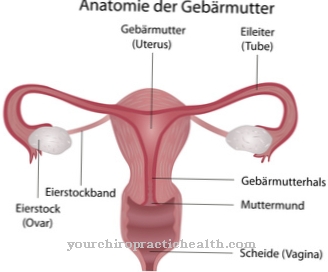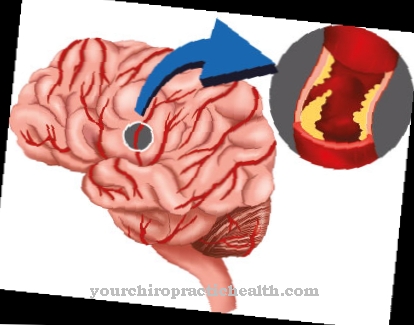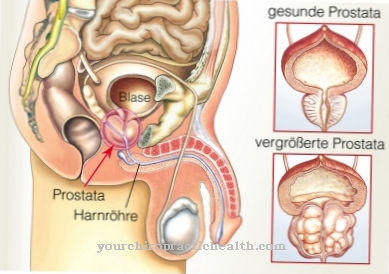A pleurisy is also known as Pleurisy or pleurisy designated. In this condition, inflammation develops within a thin layer of tissue between the lungs and the chest cavity. This layer is called the pleura or pleura. The cause of pleurisy are usually previous lung or bronchial diseases. Typical signs of pleurisy are pain when exhaling and inhaling and the resulting shortness of breath or even shortness of breath.
What is pleurisy (pleurisy)?
.jpg)
© Neyro - stock.adobe.com
From a so-called pleurisy - in medical terminology pleurisy called - one speaks when the wafer-thin tissue (called pleura), which is located between the chest and the lungs, is inflamed.
This tissue does not only include the lungs themselves, but is found extensively in the entire chest cavity and rib area. This is why those affected feel pain not only in the lungs but in the entire chest area when pleurisy is affected. In some cases there is persistent shortness of breath or even shortness of breath.
causes
A pleurisy occurs in most cases as a result of a previous illness that affected the inner chest area or the lungs - for example after severe pneumonia, severe bronchitis or even tuberculosis, as this always takes a long time to heal completely.
During the duration of the illness, due to the existing clinical picture and the symptoms occurring, mostly water collects in the irritated chest cavity. In this very common case one speaks medically of wet pleurisy. However, doctors strictly separate this type of pleurisy from so-called dry pleurisy, in which the tissue is more likely to be affected due to the breathing effort and the existing inflammation.
Pleurisy hardly ever occurs as a completely independent disease, i.e. without a corresponding disease in advance. If you suffer from such a disease as a patient, you can prevent pleurisy by strengthening the immune system as the disease progresses.
Symptoms, ailments & signs
Inflammation of the pleura manifests itself primarily through typical signs of inflammation. Affected people initially notice a slight fever and a general feeling of illness. A short time later, breathing difficulties appear: dry cough, shortness of breath and occasionally hoarseness.
The breathing sounds are creaky or rubbing, whereby this leather rubbing becomes stronger as the disease progresses, before it slowly subsides again during the recovery phase. As a result of the inflammation, the pleura becomes excessively sensitive to pain, causing sharp chest pain when breathing. Deep breaths are particularly painful, which is why many people breathe primarily through their noses and limit themselves to shallow breaths.
The characteristic breathing activity favors respiratory diseases. Pleurisy can lead to a dry, painful cough. The pain usually occurs on one side and can radiate into the shoulder and chest regions. This is accompanied by the symptoms and complaints of the respective underlying disease.
If the inflammation spreads to the diaphragm, hiccups can also occur. The symptoms of pleurisy appear two to five days after infection and get worse quickly. With immediate treatment, the symptoms will subside within a few days.
Course of disease
Patients under a pleurisy usually complain increasingly of pain when coughing and breathing. The pain begins rather inconspicuously and then slowly increases as the disease progresses. In the initial phase of pleurisy, many sufferers can still interpret the precise focus of pain, but later the pressure, often together with the pleurisy, extends to the entire chest cavity.
In other words: The patients complain of severe discomfort in the whole chest and no longer only in the lung area. As the pleurisy progresses, the feeling of pain increases. At a later stage of the disease, many people who suffer from pleurisy also complain of constant pressure in the rib area.
Complications
If the underlying disease is treated, there are usually no serious effects. However, if pleurisy is not treated in time, the risk of complications increases. The so-called pleural rind is one of the most common consequences of pleurisy. It shows up primarily in exudative pleurisy. If the inflamed pleura parts lie on top of each other for a long period of time without moving, the pleura and lung pleura can grow together.
This in turn leads to the development of a pleural callus or pleural rind. This process creates a firm connection between the lungs and the chest. As a result, the patient can no longer breathe freely because less air is taken in with each breath. Even after the pleurisy has healed, there are still limitations in lung elasticity. An operation is required to detach the pleura and pleura from each other again.
Pleural empyema, which is a purulent effusion, is a dreaded complication of pleurisy. The pleural space is filled with fluid. If the extent is small, the pleural empyema often goes unnoticed. However, if the volume increases, the lungs are no longer able to expand enough, which makes breathing difficult. The patient eventually suffers from shortness of breath.
Pleural empyema is usually triggered by bronchiectasis, bacterial pneumonia, a lung abscess or a surgical procedure inside the chest cavity. It is noticeable in coughs, high fever, night sweats and the loss of weight.
You can find your medication here
➔ Medication for chest painWhen should you go to the doctor?
A doctor should always be consulted with pleurisy. There is no self-healing in this disease and in most cases the symptoms worsen significantly if treatment is not initiated. An early diagnosis and treatment of pleurisy always has a positive effect on the further course of the disease and can prevent complications. See a doctor if the patient has severe chest pain. There is also a fever and general flu symptoms.
The pain itself can also spread to the shoulders and therefore has a very negative effect on the patient's quality of life. In most cases, there is also a cough or severe shortness of breath. Should these symptoms occur, a doctor must be consulted in any case. First and foremost, a general practitioner can be visited in the case of pleurisy. In emergencies or in the case of very severe and acute complaints, an emergency doctor can be called or the hospital can be visited directly. The pleurisy can be treated relatively well, so that the life expectancy of the patient is usually not restricted by this disease.
Treatment & Therapy
So one pleurisy to be treated really successfully, it must be diagnosed as soon as possible. If the necessary therapy is started promptly, pleurisy usually heals without any major long-term consequences. The therapy for pleurisy is less aimed at treating the pleurisy itself than at the underlying disease that causes it.
The situation is different with the complaints themselves: The pain that occurs can, after consultation with the treating doctor, be alleviated with gentle warmth, for example. In addition, strict bed rest and rest must be observed, since the patients with pleurisy are usually very short of breath. Medication is only used during pleurisy if it is compatible with the underlying disease.
In addition, respiratory therapies are often initiated to help you breathe deeply, even during painful pleurisy. It must be prevented that the patient only takes short breaths for fear of pain. This could cause the pleura to grow together with the chest. If this is the case, surgery after the pleurisy is usually unavoidable.
Aftercare
Pleurisy is associated with pronounced pain in the upper body. The person concerned feels the symptoms in everyday life as very stressful. The inflammation may indicate another organic cause. Follow-up therapy depends on the particular trigger. It also aims to relieve symptoms.
The pleurisy is said to have healed without consequences in the end. Follow-up care lasts until complete healing. If not cured sufficiently, the disease can develop in a life-threatening manner. For this reason, both treatment and follow-up measures must be taken seriously by the patient.
Computed tomography, blood tests or a pleuroscopy can provide information about the cause. It must first be treated. The pulmonologist prescribes pain-relieving and fever-lowering medicine against the inflammation. If the cause is bacterial, the patient is also given antibiotics.Aftercare ends when you stop taking the medication. The doctor will determine the exact time. Pleural effusion is suctioned off by means of a puncture in the chest cavity.
The healing progress can be recorded with regular control. Long-term consequences must be avoided. Even after the therapy has ended, the patient should attend follow-up appointments. If the pleurisy returns unexpectedly, treatment and follow-up care begin again. The specialist will arrange further examinations for clarification.
You can do that yourself
The focus of self-applicable measures in pleurisy is maintaining adequate lung ventilation and preventing inflammation of the lungs (pneumonia) as well as relieving breath-dependent pain. Various exercises can be performed to ensure ventilation of all lung areas. Of course, any prescribed painkillers should be taken beforehand with some interval to make it easier to carry out.
Children in particular have fun when asked to produce soap bubbles. All you have to do is provide a straw and a beaker of soap solution. By slowly blowing in air, the lung tissue is expanded and the body's own secretions can flow away better. Adult patients should remember to breathe deeply regularly to get the same effect. Regular walking or rubbing with rubbing alcohol or the like can also be beneficial. Under no circumstances should the person concerned start restricting his or her personal mobility because of the uncomfortable feeling.
An accompanying fever can be relieved by drinking sufficient amounts of mineral water, resting, and taking antipyretic medication. However, a high fever or a bacterial origin should be treated by a doctor.

























.jpg)

.jpg)
